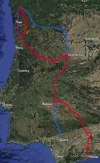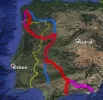Anna&Michael
Not all those who wander are lost!
- Time of past OR future Camino
- 2019
We've written a short article on walking the Camino Mozárabe. Word limits prevent us from publishing the entire article here but here's a summary of the five points. Have a look at the full article which has more detail, links to useful websites and guides, etc.

Also, read our account of walking the Camino Mozárabe to gain an insight into the experience of walking the route and for photographs that will give you a sense of the trail. Our account is in three stages to make for easy reading and planning:
1. Almería to Granada
2. Granada to Córdoba
3. Córdoba to Mérida
The Camino Mozárabe: 5 things you'll want to know (a summary)
1. Why should I consider walking the Camino Mozárabe?
You might consider walking the Camino Mozárabe because when you walked the Camino Francés, you wished you’d walked it years ago when it was less crowded. Or, maybe the Camino has got under your skin and you’re ready for a more adventurous pilgrimage.
The Camino Mozárabe is well marked and you’ll be mainly walking on old tracks and quiet minor roads. You’ll visit the history-laden cities of Granada, Córdoba and Mérida, walk past Roman ruins and visit fortified hilltop villages.
2. Give me an overview of walking the Camino Mozárabe?
It’s a fascinating route historically, culturally and scenically (although some days you walk through rows and rows of olive trees). It’s undulating/hilly for much of the route which makes for constantly changing scenery, and while it’s physically more demanding than the Camino Francés, this shouldn’t be a problem if you’re reasonably fit.
The trail is well marked but with few pilgrims on the trail you can’t rely on following the pilgrim in front of you. There are a few longer stages than on the Camino Francés (30-35km) and fewer villages overall, not all of which have accommodation or even a shop. The Camino Mozárabe is 620 kms long and can be divided into three main sections:
Almería to Granada, 200 km
Granada to Córdoba, 170 km
Córdoba to Mérida, 250 km
From Mérida, where the Camino Mozárabe meets the Via de la Plata, it’s 750 km to Santiago.
We walked from Almería to Mérida in 25 days, including a couple of rest days and one day on a bus when Michael needed treatment for shin splints.
3. Do I need to be fluent in Spanish?
You don’t need to be fluent in Spanish but it would be helpful to have enough to be able to order food, book a bed and ask the way to Santiago (pointing, sign language and translation apps can help).
4. I’m interested in walking the Camino Mozárabe, help me find out more
The very helpful amigos at Almería have information on distances, accommodation, facilities and route profiles from Almería to Mérida. While some of this information is in Spanish, the really useful bits such as maps, accommodation and trail profiles don’t require translation.
Another detailed route guide (including the Málaga route) in English is the Pilgrims Guide: Mozarab Way of Santiago. It has stage descriptions, accommodation & services information, and maps.
5. How do I find out what walking the Camino Mozárabe is like?
If you haven’t already read our story of walking the Camino Mozárbe, then click here. Hopefully, you’ll be inspired to start planning your own Camino along this fascinating route before the crowds arrive.
Summary:
Traversing Aundulicia, the Camino Mozarabe is the perfect route for those looking for a quieter trail with layers of history from vanquished civilisations, beautiful white villages, and a range of landscapes. It's a less travelled, well supported and fascinating path. Find out more.

Also, read our account of walking the Camino Mozárabe to gain an insight into the experience of walking the route and for photographs that will give you a sense of the trail. Our account is in three stages to make for easy reading and planning:
1. Almería to Granada
2. Granada to Córdoba
3. Córdoba to Mérida
The Camino Mozárabe: 5 things you'll want to know (a summary)
1. Why should I consider walking the Camino Mozárabe?
You might consider walking the Camino Mozárabe because when you walked the Camino Francés, you wished you’d walked it years ago when it was less crowded. Or, maybe the Camino has got under your skin and you’re ready for a more adventurous pilgrimage.
The Camino Mozárabe is well marked and you’ll be mainly walking on old tracks and quiet minor roads. You’ll visit the history-laden cities of Granada, Córdoba and Mérida, walk past Roman ruins and visit fortified hilltop villages.
2. Give me an overview of walking the Camino Mozárabe?
It’s a fascinating route historically, culturally and scenically (although some days you walk through rows and rows of olive trees). It’s undulating/hilly for much of the route which makes for constantly changing scenery, and while it’s physically more demanding than the Camino Francés, this shouldn’t be a problem if you’re reasonably fit.
The trail is well marked but with few pilgrims on the trail you can’t rely on following the pilgrim in front of you. There are a few longer stages than on the Camino Francés (30-35km) and fewer villages overall, not all of which have accommodation or even a shop. The Camino Mozárabe is 620 kms long and can be divided into three main sections:
Almería to Granada, 200 km
Granada to Córdoba, 170 km
Córdoba to Mérida, 250 km
From Mérida, where the Camino Mozárabe meets the Via de la Plata, it’s 750 km to Santiago.
We walked from Almería to Mérida in 25 days, including a couple of rest days and one day on a bus when Michael needed treatment for shin splints.
3. Do I need to be fluent in Spanish?
You don’t need to be fluent in Spanish but it would be helpful to have enough to be able to order food, book a bed and ask the way to Santiago (pointing, sign language and translation apps can help).
4. I’m interested in walking the Camino Mozárabe, help me find out more
The very helpful amigos at Almería have information on distances, accommodation, facilities and route profiles from Almería to Mérida. While some of this information is in Spanish, the really useful bits such as maps, accommodation and trail profiles don’t require translation.
Another detailed route guide (including the Málaga route) in English is the Pilgrims Guide: Mozarab Way of Santiago. It has stage descriptions, accommodation & services information, and maps.
5. How do I find out what walking the Camino Mozárabe is like?
If you haven’t already read our story of walking the Camino Mozárbe, then click here. Hopefully, you’ll be inspired to start planning your own Camino along this fascinating route before the crowds arrive.
Summary:
Traversing Aundulicia, the Camino Mozarabe is the perfect route for those looking for a quieter trail with layers of history from vanquished civilisations, beautiful white villages, and a range of landscapes. It's a less travelled, well supported and fascinating path. Find out more.
Last edited:



















